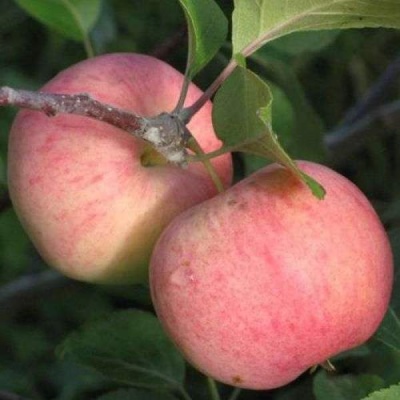
- Authors: Sverdlovsk Horticultural Selection Station
- Taste: sweet and sour
- Fruit weight, g: 75-90
- Yield: high, 50-70 kg
- Frequency of fruiting: annual
- The beginning of fruiting varieties: for 3-4 years
- Ripening terms: autumn
- Removable maturity: mid-September
- Keeping quality: 30-40 days
- Appointment: universal
The Ural (Sverdlovsk) selection school is very powerful. And among the attractive products of its activity, the Sokovoe apple tree takes not the last place. To get acquainted with its features will be relevant for apple growers from other regions of the country.
Breeding history of the variety
The culture was obtained at the Sverdlovsk selection gardening station. To get it, we had to cross the varieties Uralskoe nalivnoe and Urozhainy - the final result justified all the efforts. The work on the variety was carried out by the breeders Kotov and Makarova. The original variety appeared by the mid-1980s, later its modifications were developed, which were assigned additional numbers.
Description of the variety
The plant is distinguished by a number of excellent features. But at the same time, it does not forgive mistakes in terms of agriculture. The trees are of medium height. They are able to grow rapidly. Characteristic:
- weak thickening of the branches;
- dark green color of slightly elongated leaves;
- crown with a section of 3 m;
- annual growth at a young age up to 1 m.
Features, pros and cons
The Sokovoe apple tree has only one fundamental flaw. It consists in the fact that the fruits are relatively small. Some people think that apples are inferior in taste to fruits of other varieties. However, the plant is supported by:
- excellent climatic characteristics;
- stability of fruit production;
- versatility of crop use;
- high marketability of fruits;
- resistance to temperature fluctuations;
- resistance to excess moisture;
- low exposure to drafts;
- suitability for cultivation both on a private farm and on large plantation lands.
Ripening and fruiting
You can usually pick apples in mid-September. The first of them should be expected at 3 or 4 years of tree development. Further fruits will appear annually. In the second or third seasons, individual flowers may bloom, but "one swallow does not make spring", and such premature flowers will have to be cut off.
Growing regions
The plant is approved for growing in:
- Chuvashia;
- Kirov region;
- Republic of Mari El;
- The Mordovian Republic;
- Nizhny Novgorod and the Nizhny Novgorod region.
Yield
Apple-tree Juice is high-yielding. In terms of fertility, it is far ahead of other types of the Ural and Siberian trees. From one trunk a year, 50-70 kg of fruit are confidently harvested per year. Under favorable weather conditions, 90 kg of apples are harvested per season. Here, of course, competent agricultural technology plays an important role.
Fruits and their taste
Juice apples are versatile. They are characterized by a light cream color and a striped blush. The mass of one fruit is 0.075-0.09 kg. The juicy pulp has a sweet and sour taste, keeping quality is from 30 to 40 days.

Growing features
A standard seedling can be planted in the spring - if we are talking about the northern regions. In southern areas, autumn planting is used. It is recommended to choose sunny areas with fertile loose soil. Important requirements:
- during the growing season, at least 4 waterings will have to be carried out;
- it is necessary to systematically introduce organic and mineral additives;
- shaping and sanitary trimmings are required;
- during the growing season, thinning pruning will certainly be required, since the variety is very active;
- you cannot refuse to mulch the trunk circle (with the help of straw or humus), from its loosening.
The plant is designed for cultivation in areas with intense snowfall. This means that winter preparation must be done very carefully. Mulching the trunk circle must be carried out with a thick layer of covering material. Protection from rodents is also very important. Proper cover and lime application helps prevent their attacks.



Pollination
The variety is conditionally self-fertile. To pollinate it, only bees and at least minimal wind are needed. If neither one nor the other is not, gardeners will have to look for a way out of the situation on their own. Bee colonies are sometimes brought artificially.
Spraying the trees themselves with sugar syrup is helpful. In addition, the highest yield is brought by additional pollinators, for example, the Anis Sverdlovsky variety.
Top dressing
Nutrient input begins at year 3 of development. In the spring - as soon as the weather permits - the apple tree is watered with a solution of urea (concentration 5%). When budding begins, a combination of potassium sulfate and superphosphate is used. Consumption of drugs - 15 g for each bucket of water; it is necessary to feed the plant with the same composition when the flowers dry out. In late autumn, humus or leaf compost is embedded in the soil in an amount of 10 kg per 1 sq. m.



The apple tree is a popular fruit crop among gardeners. It can be found in many summer cottages. But at the same time, such trees are often affected by various diseases. It is very important to recognize the disease in time and carry out the necessary procedures for a speedy recovery. Otherwise, the fruits will be spoiled, and the tree itself may die altogether.

Review overview
The apple-tree Juice stands out for its excellent winter hardiness. The fruits may not boast of a large size, but they are obtained annually. Also in the reviews about this plant they note:
- a really large amount of squeezed juice;
- attractiveness of appearance;
- no special hassle when growing;
- uniformity of fruit quality and size.











































































